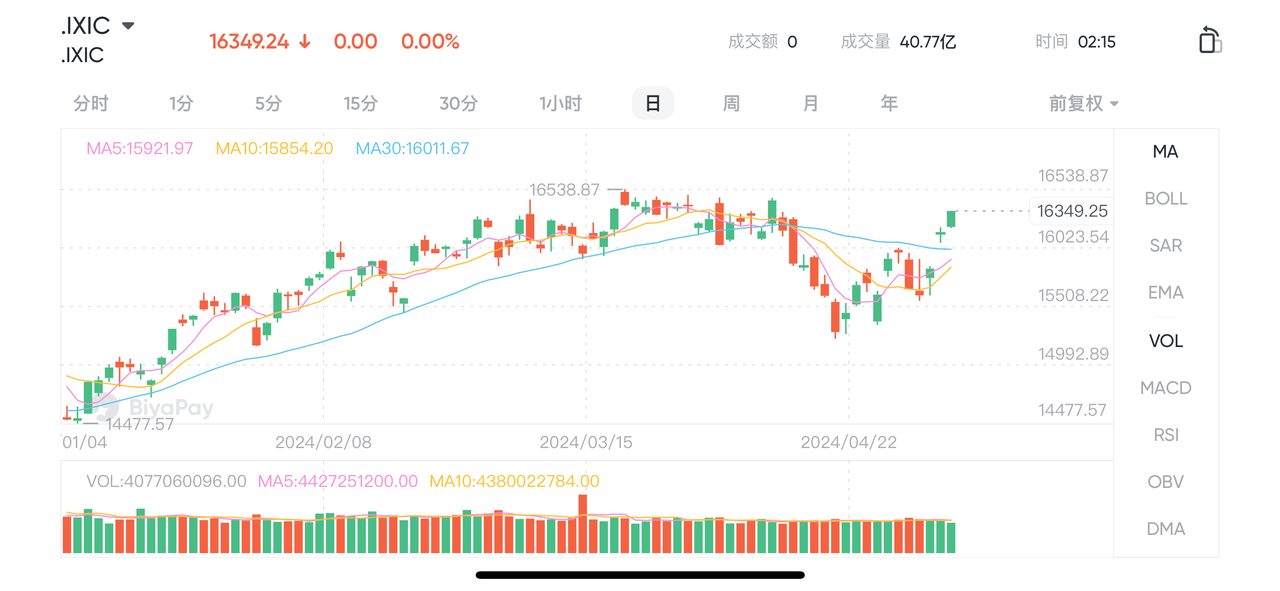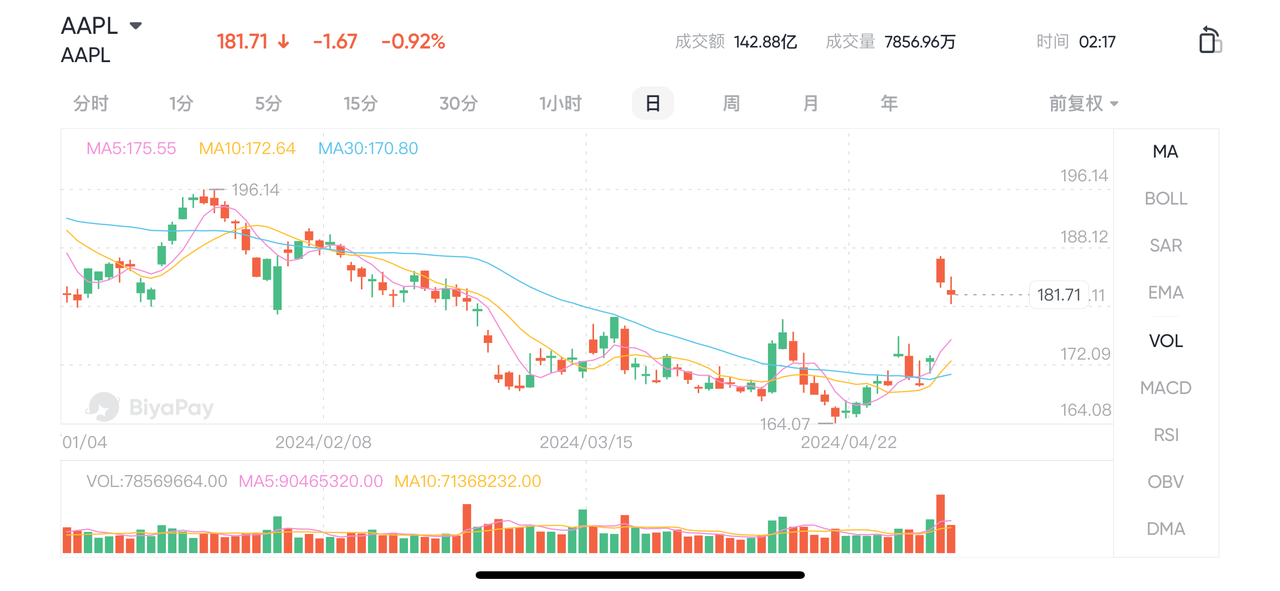- Remittance
- Exchange Rate
- Stock
- Events
- EasyCard
- More
- Download
May ushered in a good start, and the US stock market surged across the board!
After experiencing a sharp drop in the US stock market, May ushered in a good start. Currently, market expectations are gradually increasing, especially with the positive development of economic data at the beginning of the year. The late-night US stock market can be said to have soared across the board!
US stocks collectively rose
On May 3rd, all three major US stock indexes closed higher. As of the close, the Dow Jones Industrial Average rose 450.02 points, or 1.18%, to 38,675.68 points; the Nasdaq rose 315.37 points, or 1.99%, to 16,156.33 points; the S & P 500 index rose 63.59 points, or 1.26%, to 5,127.79 points. The Nasdaq 100 index, dominated by technology stocks, rose nearly 2%… Apple rose more than 5%, TSMC, ASML, NVIDIA, Broadcom rose more than 3%, Supermicro, Netflix, Meta, Microsoft, Micron Technology rose more than 2%, Texas Instruments, Intel rose more than 1%, Amazon, Cisco, Tesla, Google a rose slightly, Qualcomm fell slightly, and Eli Lilly fell more than 2%. This wave of rise can be said to have regained the confidence of US stock enthusiasts. What kind of late-night experience did the US stock market experience to rise across the board?

.IXIC,BiyaPay App
Rate cut expectations
After the data was released, the swap market re-predicted that the Federal Reserve would cut interest rates twice this year by 25 basis points. The significant cooling of the labor market will change the next move of the Federal Reserve. After the data was released, traders advanced the expectation of the first rate cut by the Federal Reserve from November this year to September. The market expected the probability of no rate cut in September to be 31.7%, compared with 38.4% the day before and 42.6% a week ago. The probability of no rate cut in December has dropped to below 10%. The US non-farm payroll data boosted the expectation of a rate cut by the Federal Reserve. In the past month, due to the Federal Reserve’s continuous statements and economic data in March, the expectation of a rate cut by the Federal Reserve has been continuously declining. The increase in US non-farm payroll employment in April released last night was significantly lower than expected, only 175,000 people, far lower than the predicted 240,000. The unemployment rate unexpectedly rose to 3.9%, and the average hourly wage growth rate also slowed to 0.2%. A string of weaker-than-expected gains in employment, services and manufacturing hit their lowest levels since February 2023.
The US non-farm payroll data is an economic indicator released by the US Bureau of Labor Statistics, reflecting the state of the US labor market. It reflects the net change in US employment, excluding the agricultural sector, during a certain period of time. If US employment growth slows down, it may indicate that the US economy is slowing down and corporate hiring activity is decreasing, which may indicate an increase in uncertainty about the US economic outlook. Therefore, the April non-farm payroll data was lower than expected, which prompted the Federal Reserve to consider cutting interest rates to stimulate the economy. The previously expected Fed rate cut will be brought forward, undoubtedly benefiting the US stock market.
The Federal Reserve considers a variety of economic indicators when formulating Monetary Policy, and the weakness of non-farm payrolls data may prompt the Federal Reserve to reassess its policy stance, including whether interest rate cuts are needed to support economic growth.
This series of data did not meet expectations, leading the market to bet that the Federal Reserve will begin to relax Monetary Policy as early as September and may cut interest rates twice this year, which is undoubtedly good news for the US stock market, especially technology stocks. Therefore, the US stock market rebounded collectively, with the Nasdaq leading the way.
Sonu Vargas of Carson Group said: “The lower-than-expected non-farm payrolls report indicates that there is not enough heat in the economy to keep inflation rising, which increases the possibility of interest rate cuts this year.” Chairperson Jerome Powell pointed out that the next step is unlikely to raise interest rates. Krishna Guha of Evercore said that due to overall weakness, the April employment report proved that Powell’s decision not to take a tough stance at the May meeting was correct and was good news for the Fed and the market. Krishna Guha added: “We are more confident that the Fed will start cutting interest rates in September.” This eased investors’ concerns that the economy may overheat or accelerate again.
Apple’s financial report boosts market confidence
Apple’s better-than-expected financial report boosted market confidence. Yesterday morning, after the US stock market closed, Apple announced its second-quarter performance for the 2024 fiscal year, which exceeded market expectations, with revenue reaching $90.75 billion and Net Profit of $23.636 billion. Although both fell, it exceeded market expectations. Apple also plans to explain its artificial intelligence strategy at the June Worldwide Developers Conference. More importantly, Apple announced a $110 billion stock buyback plan, which is the largest buyback in its history and greatly exceeds market expectations, indicating Apple’s confidence in its future.
From the perspective of Apple’s stock price, it closed up 5.98%. Apple’s stock price rose more than 7% at one point during the trading session, thanks to the company’s record-breaking stock buyback plan and third-quarter sales forecast that exceeded market expectations. After the market closed on Thursday, Apple approved an additional $110 billion stock buyback plan, which is its largest stock buyback in history. In addition, Apple also expects that the upcoming iPad event on May 7th will drive hardware business demand and restore growth momentum. Although Apple’s performance growth has been slow in the past few months, Apple is still confident in its product updates based on data. Danny Hewson, head of financial analysis, said: “Growth stocks must prove that they are still growing at a rate that satisfies their shareholders. Once growth slows down, buybacks or dividends can convince investors to maintain confidence.”
These measures not only boosted Apple’s stock price, but also strengthened the confidence of the entire market in the leading US technology stocks.

AAPL,BiyaPay App
Market adjustment, US stocks rise
The previous market adjustment created conditions for a rebound. In the past month, due to the delay of the Federal Reserve’s interest rate cut expectations and some companies’ financial reports falling short of expectations, the US stock market has continued to fluctuate and adjust, but this has been digested by the market, creating conditions for a rebound. Will the US stock market still rise afterwards?
The US stock market in May can be said to have ushered in a good start. Some friends asked, “Will the US stock market continue to rise? Is it too late to buy now?” In fact, from the data, the possibility of the US stock market continuing to rise is still relatively high. First of all, there is currently no bad news for the US stock market. Judging from the rekindled expectation of interest rate cuts, if interest rates are cut, the US stock market will rise more. Even if the Federal Reserve cuts interest rates or not, it will not affect the long-term bull market trend of the US stock market. It is just that it will rise slowly without interest rate cuts.
From the performance of technology stocks, the long-term good performance of US technology stocks has driven the continuous rise of the US stock market. For example, Microsoft, Apple, Nvidia, Amazon, and Meta all come from the technology industry, accounting for nearly a quarter of the market value. From the data, as long as these tech giants continue to rise, the US stock market will continue to rise. In recent years, these tech giants have also set new highs continuously, and the stock market can still be expected.
Based on the development trend of the US stock market, it is still a good time to invest in the US stock market now. So how should investors invest in the US stock market?
The editor suggests that investors choose investment channels that suit their risk preferences. As for investment platforms, we recommend Interactive Brokers, Jiaxin , and BiyaPay. Among them, Interactive Brokers and Jiaxin are US securities firms, but their Chinese service experience is slightly worse, but their transaction fees are really low. Another option is BiyaPay, which is a wallet-type securities firm similar to Alipay in Chinese mainland. It offers online account opening and dual-interface services in Chinese and English. Moreover, their trading varieties are very rich, not only can trade US stocks, but also Hong Kong stocks, digital currencies, and so on. It can be considered a relatively strong company.
I am now using the BiyaPay App to trade US stocks, because the platform has a benefit, that is, there is no need for overseas bank cards, you can directly exchange currency in BiyaPay, deposit Jiaxin also supports telegraphic transfer and ACH two ways, ACH deposit bank zero fees, same day arrival, the main fast and convenient.
Overall, the US stock market is currently showing a steady upward trend, with technology stocks performing well. At the same time, major tech giants are actively laying out for the future and seeking new growth points. However, the market still faces some uncertainties, and investors need to maintain a cautious attitude.

























